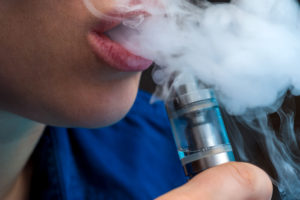Vaping advice for parents
September 19, 2019 • Uncategorized
 With currently 530 CDC-confirmed cases across the U.S., and seven deaths linked to severe breathing illnesses and lung injury from vaping, the time is now for parents to have a heart-to-heart conversation with their kids about this public health crisis, says a UNT Health Science Center researcher with experience in this area.
With currently 530 CDC-confirmed cases across the U.S., and seven deaths linked to severe breathing illnesses and lung injury from vaping, the time is now for parents to have a heart-to-heart conversation with their kids about this public health crisis, says a UNT Health Science Center researcher with experience in this area.
“For parents who know their kids are vaping, or who might not be sure if their kids do, it’s critical to sit down right away, to talk honestly about the life-threatening health risks these products can pose, and to help these kids stop vaping now,” said Tracey Barnett, PhD, Associate Professor and Associate Dean for Academic Affairs at the UNT Health Science Center College of Public Health, who has published articles on the topic and is active with parent groups and the community to share facts and warnings about e-cigarette use.
Just this week, the CDC (U.S. Centers for Disease Control) activated its Emergency Operations Center to provide increased resources and support to this outbreak, which has so far reached across 38 states and the U.S. Virgin Islands.
The crisis is primarily impacting teenagers and young adults.
Currently, the CDC estimates, about 4.7 million middle and high school-age students use at least one tobacco product, with vapes and e-cigarettes the most often used.
“Adding to the dangers of vaping posed by nicotine, there is very little known at this time about the long-term effects of inhaling the chemicals and ingredients used in vape flavor juices and mixes,” Dr. Barnett said. “Flavors that might be approved for ingestion through foods aren’t necessarily safe to take into the lungs.”
One of the most deadly examples of this involves Popcorn Lung Disease, or Popcorn Workers Lung, a serious condition discovered over a decade ago among employees in a microwave popcorn factory who died or became ill from breathing in diacetyl, one of the chemicals used to create buttery flavors.
Some companies stopped using diacetyl, but the American Lung Association says it is still found today in many popular e-cigarette flavor juices like vanilla, coconut, maple and others.
“Previous studies into vapes and e-cigs have also found particles of metals like nickel, tin and lead, as well as carcinogens like formaldehyde and certain cancer-causing toxins,” said Dr. Barnett. “What’s most frightening is that we really don’t know the full extent of vaping dangers yet.”
Patients seeking medical treatment across the U.S. have reported symptoms of cough, chest or abdominal pain, shortness of breath, fatigue, fever, nausea and vomiting, among others. The CDC recommends that people with these or other unusual symptoms who have used e-cigarette or vape products contact their healthcare provider.
“Over the last several years, tobacco and e-cigarette manufacturers have worked hard to market their products to kids, through the avenues they used for advertising, as well as the obvious flavor juice names like gummy bear, jelly bean, razzle dazzle and even the more daring ones like cheap thrill,” Dr. Barnett said. “Parents need to know there are resources to help them talk with their children about the health risks.”
Schools and school counselors are good resources, she said, as well as healthcare providers, the CDC and the Truth Initiative tobacco-free public health website. All can be helpful in providing facts and offering talking points for parents.
“We all know kids will do risky things, test boundaries and try the latest popular fads,” Dr. Barnett said, “but kids need to know that vaping is not cool, it can be deadly.”


Social media